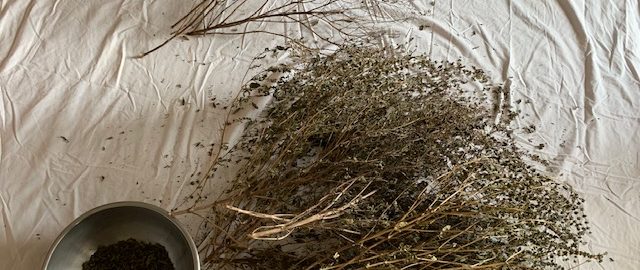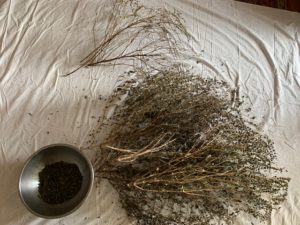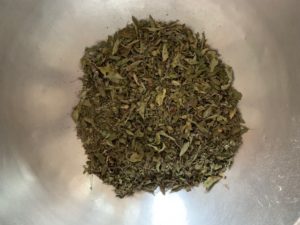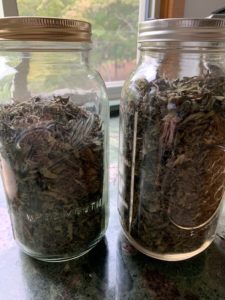Eggs are good for you when they come from healthy chickens that have free access to grass pasture, are fed an organic feed, and are properly taken care of. When the yolks are golden yellow–almost orange–and the shells hard, these are good signs. Very often even organic brands have pale yolks and thin shells. When we don’t know about the farm where our eggs are produced, it is difficult to know which brand to buy. If you don’t know your farmer and his/her practices, visit Cornucopia Institute’s organic egg scorecard. Their list and the ratings will help you make a good choice at your local, natural foods grocery. Once you find a brand that you have available locally, go to the scorecard and click on the name to open the criteria list with individual ratings. The long list of criteria which determines the rating is very educational! Check it out!
April’s Natural Face Moisturizer
What you put on your skin is as important as what you eat! Go natural with wholesome ingredients like the ones in this face moisturizer. Some ingredients are easiest to find online at iherb.com, vitacost.com, or PipingRock.com. Look for small glass jars to store your moisturizer.
Thank you, April!
Makes Two 2-ounce jars
1/4 cup shea butter
2 Tbsp. virgin coconut oil
1 tsp. vitamin E oil
1 tsp. Argan oil
1 Tbsp. cocoa butter
2 tsp. beeswax
1/2 tsp. hyaluronic acid powder
Optional for anti-inflammatory effects and pleasant scent
1/2 tsp. lavender essential oil
10 drops frankincense essential oil
10 drops sandalwood essential oil
10 drops geranium essential oil
Optional for SPF addition
1 Tbsp. zinc oxide
Melt the shea butter, coconut oil, cocoa butter and beeswax over very low heat or in a double boiler. Remove from heat and add liquid oils, vitamin E, hyaluronic acid powder, and zinc oxide if desired. Mix well and add the essential oils if desired. Stir well again. Pour while still warm and liquid into 2-ounce wide-mouthed jars. Cool until hardened. Rub fingers over moisturizer to lightly moisturize around eyes, face, and neck. Long-term storage best in refrigerator.
Baking Soda in Your Medicine Cabinet
Baking soda belongs in everyone’s “medicine cabinet” as part of their health protection plan. It’s a true blessing that it is inexpensive but still very powerful! People tend to forget about it–don’t let that happen to you!
In my opinion, everyone should brush their teeth with baking soda. Besides really cleaning/whitening the teeth and killing bacteria that cause tooth decay, it will reduce the risk of colds and infections when used daily. It can be used straight by dipping a wet toothbrush into about a 1/2 tsp. of baking soda. If you prefer using toothpaste, put some toothpaste on your toothbrush and then dip it into the baking soda.
Also, when mixed with a little water to make a paste it can be used on the skin and nails as an anti-fungal and also for itchy skin and poison ivy. After it dries rinse it off with warm water.
Baking soda can be taken internally also at a dilution of 1/4 tsp. per cup of water and preferably on an empty stomach two times a day. This provides a source of bicarbonate which buffers acids in the body. This can be helpful for the kidneys and the bladder in the case of bladder infections and interstitial cystitis; the baking soda alkalizes the urine which assists an acid-irritated bladder. There are many other benefits but these are the most important to keep in mind.
If you are trying to reduce sodium intake, use potassium bicarbonate instead. You can purchase online potassium bicarbonate.
BEWARE FAKE MEATS!
Anyone who eats needs to be informed about our food supply–it’s just too easy to make bad choices while thinking you are doing good for yourself and the planet. Check out this interview in the Price-Pottenger newsletter for the nitty-gritty on fake meats. I couldn’t agree more—Excellent job!
Is Your Inflammation From Eating the Wrong Fats?
We now offer the OmegaQuant tests for quick and easy determinations of the body’s balance of fats (pro-inflammatory vs. anti-inflammatory), vitamin D, and even hemoglobin A1C. A simple finger prick and collection of a drop of blood is all it takes. These are all very important indicators of whether the diet is anti-inflammatory, immune-system supportive, and supportive of healthy pregnancy/lactation. With these results we can make specific diet recommendations to address any insufficiencies/imbalances. Ask for more information by calling our office or scheduling an appointment with Monica.
Commit to Eating Only Organically Grown Food!
There are many good reasons for supporting organic agriculture (and having an organic garden if you can) but this one strikes home powerfully. The industry-friendly EPA allows “biosolids”, a euphemism for human sewage, to be spread as fertilizer on US farm fields. Sewage is contaminated extensively with “forever chemicals”, toxins that accumulate and persist in the sewage, in the crops, and in people who eat them. Organic standards do not allow sewage to be spread on organically certified farms so organically grown food is safe from sewage. If you buy locally, be sure to ask growers what they are using as fertilizer and whether they use “biosolids”.
Support Your Immunity
Recommendations for supporting the immune system:
- Most important recommendation–eat an anti-inflammatory diet. Basically this means no sugar, white flour products/gluten grains, vegetable oils (canola, soy, corn, sunflower, safflower, peanut). For more details on the specifics. schedule an appointment with Monica or ask for our handout in the office.
- Vitamin D3. Maintenance dose for adults is 5000 IUs a day (children ¼ to ½ of that depending on weight). If infection is beginning or has occurred, take 10,000 IUs a day of vitamin D3 for 2 or 3 days and then drop down to the maintenance dose. We recommend the powdered form (not the kind in vegetable oil in gel caps). We carry a brand that provides 5000 IUs per capsule, plus the option of a D3/K2 combo which is also powder. We also have drops of Vitamin D3/K2 emulsified in MCT oil —this works for babies and children who can’t swallow pills. Getting out in the sun has many benefits as long as you don’t overdo and burn but most of us live in areas where sun exposure year-round is not a reliable way to get vitamin D.
- Vitamin C. The VitaminCfoundation.org has many research articles linked on their site regarding the efficacy of vitamin C for viral infections. Apparently it is being used intravenously in hospitals in China for patients with corona virus infection. Read the articles on the site for more information. There are recommendations for oral vitamin C intake there also. VitaminCfoundation.com has good quality vitamin C in various forms available to order.
- Andrographis Complex. This is a MediHerb product that we have been using for cold and flu prevention for years. It is a combination of andrographis, holy basil and echinacea root extracts. It is available at our office. If you can tolerate it, place one of the tablets in your mouth and allow it to dissolve; this can instantly improve a sore throat. Another antimicrobial herb is oregano oil. We suggest NeuroHemp which besides the cannabinoids provides oregano oil. Swish a dropperful in the mouth before swallowing.
- Chaga Tea. Chaga is a mushroom that grows on birch trees in northern latitudes (Canada). It has many properties that support the immune system. Here is a recipe and a source for chaga tea.
- Zinc and Quercetin. Zinc as losengers or as liquid ionic zinc. , Some extra zinc (about 15 mgs a day) is a good measure to take as many people are low in zinc. Quercetin helps zinc to be taken up by the cells to fight infection. Don’t take extra zinc long-term unless you take extra copper also as it may create copper deficiency. Long-term it is best to rely on a multiple that has all the essential trace minerals in it to maintain adequate zinc levels. Plus a good multi will provide Vitamin A (as retinyl palmitate , not just beta-carotene) and vitamin K2 both of which help fight infections.
- Elderberry extract. Purchase online or at local healthfood stores and take the dose recommended on the bottle.
- Use the neti pot to rinse the nasal passages daily with salt water, plus brush your teeth with a drop of tea tree oil and 1/4 tsp. baking soda on your toothbrush along with your toothpaste for the anti-microbial effect of the tea tree oil. You can also gargle with a drop of tea tree oil in some hot, salt water–do this hourly to reduce microbes hanging out in the back of the throat that may or may not be causing symptoms.
- Take a good spore-based probiotic such as Just Thrive or MegaSporebiotic, which we have available in our office.
- NAC or N-acetyl cysteine is an amino acid that helps boost glutathione production in the body. NAC has benefits itself but glutathione is a major detoxifier and that alone is a good reason to take–500 mgs a day.
- Stay warm and hydrated with a variety of herbal teas, such as tulsi, licorice root, chamomile, mint. Raise the body temperature to the point of sweating to help kill viruses by sauna or hot baths.
- Breathe and get enough sleep! Diaphragmatic breathing to keep calm is a no brainer! Ask for our instruction handout. Doing this before sleep is helpful for insomnia. And if you are exposed to wifi or cell phone radiation especially at night it is having an impact on your cellular health and suppressing your immune system. Ask us for more information.
Natural Deodorant with Essential Oils
If you have a collection of essential oils you likely have what you need to make a simple, effective deodorant. You will need good quality grain ethyl alcohol too–such as Everclear or high proof vodka or gin (organic versions are available). General rule of thumb–use 10 drops of a combination of specific essential oils (listed below) per ounce of alcohol. Best not to use rubbing alcohol due to questionable purity for using on a daily basis.
We’ve been using variations of essential oils in this recipe for years and love it–always smells great and it works!
Glass 2-4 ounce spray bottle (we used an empty Weleda spray deodorant bottle)
2-4 ounces of grain alcohol
10 drops total of essential oils per ounce of grain alcohol; good choices are tea tree, lavender, chamomile, lemongrass, sage, geranium, jasmine, sweet orange, grapefruit, lemon, frankincense. Be sure to include the tea tree oil and at least 2 of the other choices that are printed in bold.
Pour the alcohol in the spray bottle. Add your combination of essential oils. Shake before application.
Healing Moisturizing Oil
This is a recipe too but one for topical use only! Castor oil is very healing (to learn more, read “The Oil That Heals” by Dr. William McGarey) and belongs in everyone’s medicine cabinet. Many people have used it as a castor oil pack as recommended by Edgar Cayce and McGarey’s book explains how to do this. It is best used topically as the book explains unless you know what you are doing and wish to use it internally as a laxative!
However, to use topically as a massage or moisturizing oil it is too thick and sticky to use alone. Diluting it with a highly-absorbed oil such as argan is the key for using this therapeutic oil as a healing massage oil. The essential oils make it a delight to the senses and add to its healing properties. If you get massages, bring it to your therapist and ask her/him to use this instead of standard massage oils.
In general, for massage oils, use up to 15 drops total of essential oil(s) per ounce of castor/argan oil mixture. Make it in small batches (2-4 ounces) for freshness.
1 part castor oil ( be sure to buy organic, cold-pressed, solvent-free)
1 part argan oil (organic, cold-pressed, or jojoba oil)
a couple drops of vitamin E oil (optional)
frankincense essential oil
lavender essential
Pour equal parts castor oil and argan oil into a glass bottle. Cap and shake well. ( I use a 4 ounce brown glass spray bottle that the argan oil comes in.) Add the essential oils one drop at a time so you can count them. Add the vitamin E oil if desired. Shake again. Massage into sprain/strains, sore or inflamed areas, tight muscles, feet, hands. Also can be used on the face by bathing the face first with a warm wash cloth, putting a couple drops of the blend on the wash cloth, and brushing over the face–very light and feels great!
Holy Basil DIY
This powerful adaptogen herb is easy to grow, fragrant, attractive, loved by honeybees (so you are not just growing for your own benefit!), easy to harvest, easy to dry, fun and easy to strip/store, and makes a yummy tea that you wouldn’t think would be highly medicinal! What an olfactory experience that I totally enjoy!
 Here are some volunteer baby plants near a mature plant.
Here are some volunteer baby plants near a mature plant.
I’ve posted a tea recipe previously but here I encourage folks to grow it themselves–even if you only have a patio or balcony, as long as you have at least half a day’s worth of direct sun, you can do it in a planter. It can be started indoors in the Spring and planted outside once danger of frost is over– so you have until Spring to find some seeds (many seed catalogs have it–I prefer the “purple” variety). Some nurseries carry the seedlings in the Spring but it is not that easy to find. Here a few pictures that may inspire you.
I cut the plant at the base in late Summer or early Fall while there are still lots of green leaves but not too many flower spikes. Then the plant can be hung upside down with some string in a dark, dry, warm area. We have a shed that is perfect for drying. After 3-4 weeks it will be thoroughly dry and the leaves will be ready for stripping. In the photo above, notice several dried plants, the bowl of leaves that I stripped off the plants, and the bare plant that I discard–all on a sheet that makes it easy to gather loose leaves when you are cleaning up.
Here is the finished product–just the dried leaves. I store them in a glass mason jars. A gallon lasts me all year long until the next year’s harvest. Great fun–give it a try!




